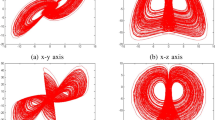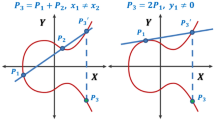Abstract
The security strength of the elliptic curve cryptosystems (ECC) is due to its core operations-based group law. This aspect of the elliptic curve provides key service to ensure security against modern cryptanalysis. However, the excess use of group law in EC based algorithms make it computationally hard for real time applications. In this context, this paper presented a smart-like algorithm based on subgroup co-set operations. The suggested scheme uses all co-sets that generates multiple sequences that can smoothly be adopted in most promising communication architectures of the future such as internet of things (IoT). Besides, the subgroup structure on a small prime with possible embedding is managed to construct efficient substitution box (S-box). Whereas, the performance of the proposed S-box is examined via standardized tests thus found significant for multimedia data security applications. Moreover, a small prime based EC subgroup coset model is designed, that generates a set of experimentally verified independent pseudo random streams. The atypical mathematical model for its application to image data encryption is established, by combining the S-box module (SM) and subgroup coset module (ES-PM). Several statistical tests revealed that the proposed technique is suitable for various cryptographic applications.









Similar content being viewed by others
References
Abd el-Latif AA, Abd-el-Atty B, Amin M, Iliyasu AM (2020) Quantum-inspired cascaded discrete-time quantum walks with induced chaotic dynamics and cryptographic applications. Sci Rep 10(1):1–16
Abd El-Latif AA, Niu X (2013) A hybrid chaotic system and cyclic elliptic curve for image encryption. AEU-Int J Electr Commun 67(2):136–143
Adams C, Tavares S (1990) The structured Design of Cryptographically Good S-boxes. J Cryptol 3:27–41
Akhshani A, Akhavan A, Mobaraki A, Lim SC, Hassan Z (2014) Pseudo random number generator based on quantum chaotic map. Commun Nonlinear Sci Numer Simul 19(1):101–111
Azimi Z, Ahadpour S (2020) Color image encryption based on DNA encoding and pair coupled chaotic maps. Multimed Tools Appl 79(3):1727–1744
Bansal M, Kumar M, Kumar M, Kumar K (2021) An efficient technique for object recognition using Shi-Tomasi corner detection algorithm. Soft Comput 25(6):4423–4432
Brown J, Zhang JF, Zhou B, Mehedi M, Freitas P, Marsland J, Ji Z (2020) Random-telegraph-noise-enabled true random number generator for hardware security. Sci Rep 10(1):1–13
Çavuşoğlu Ü, Zengin A, Pehlivan I, Kaçar S (2017) A novel approach for strong S-box generation algorithm design based on chaotic scaled Zhongtang system. Nonlinear Dyn 87(2):1081–1094
Chhabra P, Garg NK, Kumar M (2020) Content-based image retrieval system using ORB and SIFT features. Neural Comput & Applic 32(7):2725–2733
Farwa S, Bibi N, Muhammad N (2020) An efficient image encryption scheme using Fresnelet transform and elliptic curve based scrambling. Multimed Tools Appl 79(37):28225–28238
Gallian J (2010) Contemporary Abstract Algebra , Cengage Learning, Exercise 43 (p. 84). ISBN 978-0-547-16509-7
Garg D, Garg NK, Kumar M (2018) Underwater image enhancement using blending of CLAHE and percentile methodologies. Multimed Tools Appl 77(20):26545–26561
Haider MI, Ali A, Shah D, Shah T (2020) Block cipher’s nonlinear component design by elliptic curves: an image encryption application. Multimed Tools Appl 1–26
Hussain I, Shah T, Mahmood H, Gondal MA (2013) A projective general linear group based algorithm for the construction of substitution box for block ciphers. Neural Comput & Applic 22(6):1085–1093
Ibrahim S, Alharbi A (2020) Efficient image encryption scheme using Henon map, dynamic S-boxes and elliptic curve cryptography. IEEE Access 8:194289–194302
Jia N, Liu S, Ding Q, Wu S, Pan X (2016) A new method of encryption algorithm based on Chaos and ECC. J Inf Hiding Multimed Signal Process 7(3):637–643
Jiang H, Belkin D, Savel’ev SE, Lin S, Wang Z, Li Y, … Barnell M (2017) A novel true random number generator based on a stochastic diffusive memristor. Nat Commun 8(1):1–9
Koblitz N (1987) Elliptic curve cryptosystems. Math Comput 48(177):203–209
Kumar M, Bansal M, Kumar M (2020) 2D object recognition techniques: state-of-the-art work. Arch Comput Methods Eng 2
Kumar M, Chhabra P, Garg NK (2018) An efficient content based image retrieval system using BayesNet and K-NN. Multimed Tools Appl 77(16):21557–21570
Lai X, Massey JL (1990). A proposal for a new block encryption standard. In workshop on the theory and application of of cryptographic techniques (pp 389-404). Springer, Berlin, Heidelberg
Li W, Chang X, Yan A, Zhang H (2021) Asymmetric multiple image elliptic curve cryptography. Opt Lasers Eng 136:106319
Liu Q, Liu L (2020) Color image encryption algorithm based on DNA coding and double Chaos system. IEEE Access 8:83596–83610
Liu G, Yang W, Liu W, Dai Y (2015) Designing S-boxes based on 3-D four-wing autonomous chaotic system. Nonlinear Dyn 82(4):1867–1877
Matsui M (1993) Linear cryptanalysis method of DES cipher. In advances in cryptology, proceedings of the workshop on the theory and application of of cryptographic techniques (EURO-CRYPT-93), Lofthus, Norway, 23–27; Springer: Berlin/Heidelberg, German
Miller VS (1985) Use of elliptic curves in cryptography. In conference on the theory and application of cryptographic techniques (pp. 417-426). Springer, Berlin, Heidelberg
Monika MK, Kumar M (2020) XGBoost: 2D-object recognition using shape descriptors and extreme gradient boosting classifier. Computational methods and data engineering: proceedings of ICMDE 2020, volume 1, 1227, 207
Nian-Sheng L (2011) Pseudo-randomness and complexity of binary sequences generated by the chaotic system. Commun Nonlinear Sci Numer Simul 16(2):761–768
Özkaynak F (2019) Construction of robust substitution boxes based on chaotic systems. Neural Comput & Applic 31(8):3317–3326
Özkaynak F, Çelik V, Özer AB (2017) A new S-box construction method based on the fractional-order chaotic Chen system. SIViP 11(4):659–664
Ramesh A, Jain A (2015) Hybrid image encryption using Pseudo random number generators, and transposition and substitution techniques. In 2015 international conference on trends in automation, communications and computing technology (I-TAC
Ran Q, Wang L, Ma J, Tan L, Yu S (2018) A quantum color image encryption scheme based on coupled hyper-chaotic Lorenz system with three impulse injections. Quantum Inf Process 17(8):188
Reyad O, Kotulski Z (2015) Image encryption using koblitz’s encoding and new mapping method based on elliptic curve random number generator. In international conference on multimedia communications, services and security (pp. 34-45). Spri
Reyad O, Kotulski Z, Abd-Elhafiez WM (2016) Image encryption using chaos-driven elliptic curve pseudo-random number generators. Appl Math Inf Sci 10(4):1283–1292
Shah T, Ali A, Khan M, Farooq G, de Andrade AA (2020) Galois ring $$ GR\left ({2^{3}, 8}\right) $$ GR23, 8 dependent $ $24\times 24$ $24× 24 S-box design: an RGB image encryption application. Wirel Pers Commun 113(2):1201–1201
Shah D, Shah T (2020) A novel discrete image encryption algorithm based on finite algebraic structures. Multimed Tools Applic 1–20
Shah D, Shah T (2020) Binary Galois field extensions dependent multimedia data security scheme. Microprocess Microsyst 77:103181
Shah D, Shah T, Jamal SS (2019) A novel efficient image encryption algorithm based on affine transformation combine with linear fractional transformation. Multidimensional Syst Signal Process 1–21
Shannon CE (1949) Communication theory of secrecy systems. Bell Syst Tech J 28(4):656–715
Te Chiang Y, Wang HS, Wang YN (2013) A chaotic-based Pseudo-random bit generator for navigation applications. Appl Mech Mater 311:99–104
Toughi S, Fathi MH, Sekhavat YA (2017) An image encryption scheme based on elliptic curve pseudo random and advanced encryption system. Signal Process 141:217–227
ul Haq T, Shah T (2020) 12× 12 S-box design and its application to RGB image encryption. Optik 164922:164922. https://doi.org/10.1016/j.ijleo.2020.164922
ul Haq T, Shah T (2020) Algebra-chaos amalgam and DNA transform based multiple digital image encryption. J Inf Secur Appl 54:102592
USC-SIPI. Image database. Available at http://sipi.usc.edu/database/database.php
Wang X, Çavuşoğlu Ü, Kacar S, Akgul A, Pham VT, Jafari S, Alsaadi F, Nguyen XQ (2019) S-box based image encryption application using a chaotic system without equilibrium. Appl Sci 9(4):781
Wang X, Guan N, Zhao H, Wang S, Zhang Y (2020) A new image encryption scheme based on coupling map lattices with mixed multi-chaos. Sci Rep 10(1):1–15
Wang Y, Liu Z, Ma J, He H (2016) A pseudorandom number generator based on piecewise logistic map. Nonlinear Dyn 83(4):2373–2391
Washington LC (2008) Elliptic curves: number theory and cryptography. CRC Press
Webster A, Tavares SE (1985) On the design of S-boxes. In Conference on the Theory and Application of Cryptographic Techniques; Springer: Berlin/Heidelberg, Germany; pp 523–534
Xuejing K, Zihui G (2020) A new color image encryption scheme based on DNA encoding and spatiotemporal chaotic system. Signal Process Image Commun 80:115670
Ye G, Jiao K, Huang X, Goi BM, Yap WS (2020) An image encryption scheme based on public key cryptosystem and quantum logistic map. Sci Rep 10(1):1–19
Ye T, Zhimao L (2018) Chaotic S-box: six-dimensional fractional Lorenz–duffing chaotic system and O-shaped path scrambling. Nonlinear Dyn 94(3):2115–2126
Yu SS, Zhou NR, Gong LH, Nie Z (2020) Optical image encryption algorithm based on phase-truncated short-time fractional Fourier transform and hyper-chaotic system. Opt Lasers Eng 124:105816
Zahid AH, Arshad MJ (2019) An innovative design of substitution-boxes using cubic polynomial mapping. Symmetry 11(3):437
Zhang YQ, He Y, Li P, Wang XY (2020) A new color image encryption scheme based on 2DNLCML system and genetic operations. Opt Lasers Eng 128:106040
Author information
Authors and Affiliations
Corresponding author
Ethics declarations
Conflict of interest
The authors declare no conflict of interest
Additional information
Publisher’s note
Springer Nature remains neutral with regard to jurisdictional claims in published maps and institutional affiliations.
Rights and permissions
About this article
Cite this article
Haider, M.I., Shah, T., Ali, A. et al. Pseudo random sequences based on elliptic curve subgroups and mathematical model for its application to digital image security. Multimed Tools Appl 81, 23709–23734 (2022). https://doi.org/10.1007/s11042-022-12358-5
Received:
Revised:
Accepted:
Published:
Issue Date:
DOI: https://doi.org/10.1007/s11042-022-12358-5




